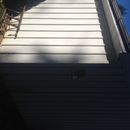External air barrier and batt insulation
If batt insulation is used along with an internal air barrier (drywall system) do I still need an external air barrier? I mean, if there were no good air barrier on the outside, wouldn’t cold air from the outside blow into the fiberglass or rockwool and kill its insulation properties, regardless of how tight the drywall barrier was?
I ask because I am insulating a pole barn workshop that currently has nothing more than board and batten siding and woven housewrap on the outside to block the wind (no sheathing). The housewrap is punctured by various nail holes used to mount the siding onto the wood purlins. It was not installed to be an air barrier (with taped seams, etc).
I have considered going over the existing woven housewrap with a second layer (installed from the inside) — I am sure I could actually make it pretty airtight from floor to ceiling this way, since I could just buy a long roll and wrap it around the inside of the entire building once around, following its contours and taping/sealing where needed. It would literally be seamless. (Then, over this sheet I could frame out the walls with studs, batt insulation and drywall.) The ceiling would tie into this external air barrier to complete the sealed envelope.
But wouldn’t it be overkill? I mean, I already plan on making an internal air barrier using drywall. And I worry about what happens if water somehow gets between the existing wrb and the added housewrap — the purlins and poles will be sandwiched between two waterproof sheets!
I know there are a lot of questions there, but the two main ones are:
1. Will an internal air barrier be enough to make rockwool/fiberglass batts work, or do I need both an internal and an external air barrier?
2. Will having two distinct layers of wrb (one on the outside of the purlins, and one on the inside) create a water or moisture management problem?
I worry about these kinds of things, but I have to keep telling myself — its just a barn!
What do you think?
Thanks very much!
GBA Detail Library
A collection of one thousand construction details organized by climate and house part











Replies
Jack,
Two WRB layers will not cause any problems.
If you are planning to use fiberglass or rock wool as your insulation, installing a decent air barrier on both sides of the insulation is a good idea. (The Energy Star Homes program requires that fiberglass batts be protected by an air barrier on all six sides.)
For more information on this issue, see One Air Barrier or Two?
Thank you for the response -- I am still hoping the existing housewrap is sufficient, if I tie it into the rest of the envelope correctly. I'm hoping I won't need the additional housewrap hassle.
From what I can tell, the only air holes in the existing housewrap are from nailing the siding boards to the purlins. Every board is nailed at each purlin with siding nails (the battens are then nailed to the boards) I think I would be OK if I believed that the pressure of the siding board against the purlin effectively sealed these holes. Or maybe the hole from a tiny siding nail is not anything to worry about anyway.
In other words, is it see no evil hear no evil when it comes to these nail holes?
-Jack
By the way, the existing WRB is Barricade brand. Their website says the stuff is designed primarily as an air barrier. If you saw the stuff, you would not believe it though. It looks like a straw hat woven out of the grass from the bottom of an easter basket.
Jack,
The WRB will certainly reduce air flow significantly. Most builders would say, "you're good."
Ultimately, though, the details of your air barrier installation depend on your goals. I think your workshop will be fine. If you were building a Passivhaus, my answer might be different.
Thanks for your response. I agree I should be good to go, although I may spray a bead of foam behind each post to block drafts (and fire/rodents) from moving between each bay freely.
The reason I'm using rock wool is because the Barricade datasheet states "not intended as primary water resistant barrier" -- go figure. So, in the absence of an additional layer of housewrap or sheathing I figured I should make my insulation water resistant.
Thanks for all your advice and the wisdom shared at this site.